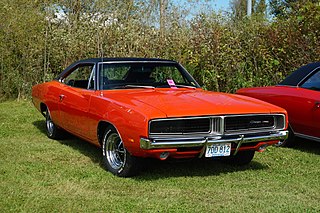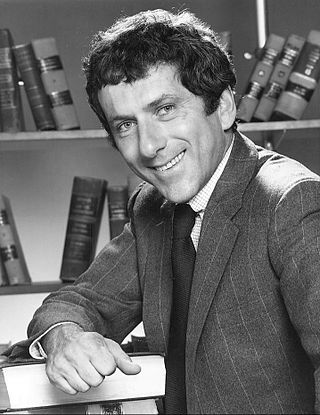
The NASCAR Xfinity Series (NXS) is a stock car racing series organized by NASCAR. It is promoted as NASCAR's second-tier circuit to the organization's top level Cup Series. NXS events are frequently held as a support race on the day prior to a Cup Series event scheduled for that weekend.

The Dodge Charger is a model of automobile marketed by Dodge in various forms over eight generations since 1966.

Cleavon Jake Little was an American stage, film and television actor. He began his career in the late 1960s on the stage. In 1970, he starred in the Broadway production of Purlie, for which he earned both a Tony Award and a Drama Desk Award. His first leading television role was that of the irreverent Dr. Jerry Noland on the ABC sitcom Temperatures Rising (1972–1974). While starring in the sitcom, Little appeared in what has become his signature performance, portraying Sheriff Bart in the 1974 Mel Brooks comedy film Blazing Saddles.

A car chase or vehicle pursuit is the vehicular overland chase of one party by another, involving at least one automobile or other wheeled motor vehicle, commonly hot pursuit of suspects by law enforcement. The rise of the automotive industry in the 20th century increased car ownership, leading to a growing number of criminals attempting to evade police in their own vehicle or a stolen car. Car chases may also involve other parties in pursuit of a criminal suspect or intended victim, or simply in an attempt to make contact with a moving person for non-conflict reasons.

Dirty Mary, Crazy Larry is a 1974 American road crime drama film based on the 1963 Richard Unekis novel titled The Chase. Directed by John Hough, the film stars Peter Fonda, Susan George, Adam Roarke, and Vic Morrow. Although Jimmie Haskell is credited with writing the music score, the soundtrack contains no incidental music apart from the theme song "Time ", sung by Marjorie McCoy, over the opening and closing titles, and a small amount of music heard over the radio.
William Carey Loftin was an American professional stuntman, stunt coordinator and actor in the U.S. film industry. He is considered to be one of the film industry's most accomplished stunt drivers. In a lengthy career spanning 61 years, his body of work included classic films such as Thunder Road, Bullitt, Vanishing Point, Duel, and The French Connection. He was posthumously inducted into the AMA Motorcycle Hall of Fame in 2001.

Two-Lane Blacktop is a 1971 American road movie directed and edited by Monte Hellman, written by Rudy Wurlitzer and starring singer-songwriter James Taylor, the Beach Boys drummer Dennis Wilson, Warren Oates, and Laurie Bird.

Barry Foster Newman was an American actor of stage, screen and television known for his portrayal of Kowalski in Vanishing Point, and for his title role in the 1970s television series Petrocelli. He was nominated for Golden Globe and Emmy awards.

"Show Me How to Live" is a song by the American rock supergroup Audioslave. It was released in June 2003 as the third single from their first album, Audioslave, released in 2003. It peaked at number 67 on the Billboard Hot 100 singles chart, number 2 on the Mainstream Rock Tracks and number 4 in the Modern Rock Tracks.

William Hickman was an American professional stunt driver, stunt coordinator and actor in the U.S. film industry. His film career spanned from the 1950s through to the late 1970s, and included films such as Bullitt, The French Connection and The Seven-Ups.
Richard Caspar Sarafian was an Armenian-American film director and actor. He compiled a versatile career that spanned over five decades as a director, actor, and writer. Sarafian is best known as the director of the 1971 film Vanishing Point and the classic The Twilight Zone episode "Living Doll".

Cotton Comes to Harlem is a 1970 American neo-noir action comedy film co-written and directed by Ossie Davis and starring Godfrey Cambridge, Raymond St. Jacques, and Redd Foxx. The film, later cited as an early example of the blaxploitation genre, is based on Chester Himes' novel of the same title. The opening theme, "Ain't Now But It's Gonna Be," was written by Ossie Davis and performed by Melba Moore. The film was one of the many black films that appeared in the 1970s and became overnight hits. It was followed two years later by the sequel Come Back, Charleston Blue.

Death Proof is a 2007 American action slasher film written and directed by Quentin Tarantino. It stars Kurt Russell as a stuntman who murders young women with modified cars he purports to be "death-proof". Rosario Dawson, Vanessa Ferlito, Jordan Ladd, Rose McGowan, Sydney Tamiia Poitier, Tracie Thoms, Mary Elizabeth Winstead, and Zoë Bell co-star as the women he targets.

Vanishing Point is a 1997 American action television film written and directed by Charles Robert Carner and starring Viggo Mortensen, Jason Priestley, Peta Wilson, Christine Elise, and Keith David. A remake of the 1971 film of the same name, it aired on the Fox television network on January 7, 1997. It features the same model 1970 Dodge Challenger R/T as the original film.

"Kowalski" is a song by Scottish rock band Primal Scream, released on 5 May 1997 as the lead single from their fifth studio album Vanishing Point. The song contains a drum sample from "Halleluhwah" by Can and an interpolation of the bassline from "Get Off Your Ass and Jam" by Funkadelic, and is named after the main character of the 1971 film Vanishing Point, played by Barry Newman; it also features various dialogue samples from this film.

Wanderlust is a 2006 documentary film on road movies and their effect on American culture.

Stingray is a 1978 action comedy film written and directed by Richard Taylor. The film was released theatrically by Avco Embassy Pictures in August 1978. The plot concerns two buddies who buy a 1964 Corvette Stingray, unaware that it is filled with drugs and stolen money. The crooks responsible for planting it in the car soon give chase, along with a number of clueless police officers. It was filmed primarily in Edwardsville, Illinois.

Fear Is the Key is a 1972 British action thriller film directed by Michael Tuchner and starring Barry Newman and Suzy Kendall. It is based on the 1961 novel of the same title by Alistair MacLean. It was the feature film debut of Ben Kingsley. The soundtrack is by Roy Budd.

The NASCAR Cup Series is the top racing series of the National Association for Stock Car Auto Racing (NASCAR). The series began in 1949 as the Strictly Stock Division, and from 1950 to 1970 it was known as the Grand National Division. In 1971, when the series began leasing its naming rights to the R. J. Reynolds Tobacco Company, it was referred to as the NASCAR Winston Cup Series (1971–2003). A similar deal was made with Nextel in 2003, and it became the NASCAR Nextel Cup Series (2004–2007). Sprint acquired Nextel in 2005, and in 2008 the series was renamed the NASCAR Sprint Cup Series (2008–2016). In December 2016, it was announced that Monster Energy would become the new title sponsor, and the series was renamed the Monster Energy NASCAR Cup Series (2017–2019). In 2019, NASCAR rejected Monster's offer to extend the naming rights deal beyond the end of the season. NASCAR subsequently announced its move to a new tiered sponsorship model beginning with the 2020 season similar to other U.S. based professional sports leagues, where it was simply known as the NASCAR Cup Series, with the sponsors of the series being called Premier Partners. The four Premier Partners are Busch Beer, Coca-Cola, GEICO, and Xfinity.
















